Vertebrate
| Vertebrates Temporal range: Cambrian - Present,[1] 525–0 Ma | |
|---|---|
 | |
| Individual organisms from each major vertebrate group. Clockwise, starting from top left:
Fire salamander (Amphibia), saltwater crocodile (Reptilia), southern cassowary (Aves), black-and-rufous giant elephant shrew (Mammalia), ocean sunfish (Osteichthyes) | |
| Scientific classification | |
| Kingdom: | Animalia |
| Phylum: | Chordata |
| Clade: | Craniata |
| Subphylum: | Vertebrata J-B. Lamarck, 1801[2] |
| Simplified grouping (see text) | |
| Synonyms | |
|
Ossea Batsch, 1788[2] | |
Vertebrates /ˈvɜːrtᵻbrᵻts/ comprise all species of animals within the subphylum Vertebrata /-ɑː/ (chordates with backbones). Vertebrates represent the overwhelming majority of the phylum Chordata, with currently about 64,000 species described.[3] Vertebrates include the jawless fish and the jawed vertebrates, which include the cartilaginous fish (sharks and rays) and the bony fish. A bony fish clade known as the lobe-finned fishes is included with tetrapods, which are further divided into amphibians, reptiles, mammals, and birds. Extant vertebrates range in size from the frog species Paedophryne amauensis, at as little as 7.7 mm (0.30 in), to the blue whale, at up to 33 m (108 ft). Vertebrates make up about 4% of all described animal species; the rest are invertebrates, which lack vertebral columns.
The vertebrates traditionally include the hagfish, which do not have proper vertebrae, though their closest living relatives, the lampreys, do.[4] Hagfish do, however, possess a cranium. For this reason, the vertebrate subphylum is sometimes referred to as "Craniata" when discussing morphology. Molecular analysis since 1992 has suggested that the hagfish are most closely related to lampreys,[5] and so also are vertebrates in a monophyletic sense. Others consider them a sister group of vertebrates in the common taxon of craniata.[6]
Etymology
The word vertebrate derives from the Latin word vertebratus (Pliny), meaning joint of the spine.[7] It is closely related to the word vertebra, which refers to any of the bones or segments of the spinal column.[8]
Anatomy and morphology
All vertebrates are built along the basic chordate body plan: a stiff rod running through the length of the animal (vertebral column or notochord),[9] with a hollow tube of nervous tissue (the spinal cord) above it and the gastrointestinal tract below. In all vertebrates, the mouth is found at, or right below, the anterior end of the animal, while the anus opens to the exterior before the end of the body. The remaining part of the body continuing after of the anus forms a tail with vertebrae and spinal cord, but no gut.[10]
Vertebral column
The defining characteristic of a vertebrate is the vertebral column, in which the notochord (a stiff rod of uniform composition) found in all chordates has been replaced by a segmented series of stiffer elements (vertebrae) separated by mobile joints (intervertebral discs, derived embryonically and evolutionarily from the notochord). However, a few vertebrates have secondarily lost this anatomy, retaining the notochord into adulthood, such as the sturgeon[11] and the Latimeria. Jawed vertebrates are typified by paired appendages (fins or legs, which may be secondarily lost), but this is not part of the definition of vertebrates as a whole.

Gills
.jpg)
All basal vertebrates breathe with gills. The gills are carried right behind the head, bordering the posterior margins of a series of openings from the esophagus to the exterior. Each gill is supported by a cartilagenous or bony gill arch.[12] The bony fish have three pairs of arches, cartilaginous fish have five to seven pairs, while the primitive jawless fish have seven. The vertebrate ancestor no doubt had more arches, as some of their chordate relatives have more than 50 pairs of gills.[10]
In amphibians and some primitive bony fishes, the larvae bear external gills, branching off from the gill arches.[13] These are reduced in adulthood, their function taken over by the gills proper in fishes and by lungs in most amphibians. Some amphibians retain the external larval gills in adulthood, the complex internal gill system as seen in fish apparently being irrevocably lost very early in the evolution of tetrapods.[14]
While the higher vertebrates do not have gills, the gill arches form during fetal development, and lay the basis of essential structures such as jaws, the thyroid gland, the larynx, the columella (corresponding to the stapes in mammals) and in mammals the malleus and incus.[10]
Central nervous system
The central nervous system of vertebrates is based on a hollow nerve cord running along the length of the animal. Of particular importance and unique to vertebrates is the presence of neural crest cells. These are progenitors of stem cells, and critical to coordinating the functions of cellular components.[15] Neural crest cells migrate through the body from the nerve cord during development, and initiate the formation of neural ganglia and structures such as the jaws and skull.[16][17][18]
The vertebrates are the only chordate group to exhibit cephalisation, the concentration of brain functions in the head. A slight swelling of the anterior end of the nerve cord is found in the lancelet, though it lacks the eyes and other complex sense organs comparable to those of vertebrates. Other chordates do not show any trends towards cephalisation.[10]
A peripheral nervous system branches out from the nerve cord to innervate the various systems. The front end of the nerve tube is expanded by a thickening of the walls and expansion of the central canal of spinal cord into three primary brain vesicles: The prosencephalon (forebrain), mesencephalon (midbrain) and rhombencephalon (hindbrain), further differentiated in the various vertebrate groups.[19] Two laterally placed eyes form around outgrowths from the midbrain, except in hagfish, though this may be a secondary loss.[20][21] The forebrain is well developed and subdivided in most tetrapods, while the midbrain dominate in many fish and some salamanders. Vesicles of the forebrain are usually paired, giving rise to hemispheres like the cerebral hemispheres in mammals.[19]
The resulting anatomy of the central nervous system, with a single hollow nerve cord topped by a series of (often paired) vesicles, is unique to vertebrates. All invertebrates with well-developed brains, such as insects, spiders and squids, have a ventral rather than dorsal system of ganglions, with a split brain stem running on each side of the mouth or gut.[10]
Evolutionary history
First vertebrates

Vertebrates originated about 525 million years ago during the Cambrian explosion, which saw the rise in organism diversity. The earliest known vertebrate is believed to be the Myllokunmingia.[1] Another early vertebrate is Haikouichthys ercaicunensis. Unlike the other fauna that dominated the Cambrian, these groups had the basic vertebrate body plan: a notochord, rudimentary vertebrae, and a well-defined head and tail.[22] All of these early vertebrates lacked jaws in the common sense and relied on filter feeding close to the seabed.[23] A vertebrate group of uncertain phylogeny, small-eel-like conodonts, are known from microfossils of their paired tooth segments from the late Cambrian to the end of the Triassic.[24]
From fish to amphibians
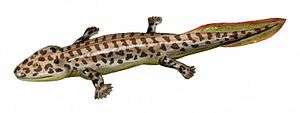
The first jawed vertebrates appeared in the latest Ordovician and became common in the Devonian, often known as the "Age of Fishes".[25] The two groups of bony fishes, the actinopterygii and sarcopterygii, evolved and became common.[26] The Devonian also saw the demise of virtually all jawless fishes, save for lampreys and hagfish, as well as the Placodermi, a group of armoured fish that dominated the entirety of that period since the late Silurian. The Devonian also saw the rise of the first labyrinthodonts, which was a transitional form between fishes and amphibians.
Mesozoic vertebrates
The Amniotes branched from labyrinthodonts in the subsequent Carboniferous period. The Parareptilia and synapsid amniotes were common during the late Paleozoic, while the diapsids became dominant during the Mesozoic. In the sea, the bony fishes became dominant. The birds a derived form of dinosaurs evolved in the Jurassic.[27] The demise of the non avian dinosaurs at the end of the Cretaceous allowed for expansion of the mammals, which had evolved from the therapsids, a group of synapsid amniotes, during the late Triassic Period.
After the Mesozoic
The Cenozoic world has seen great diversification of bony fishes, frogs, birds and mammals.
Over half of all living vertebrate species (about 32,000 species) are fishes (non-tetrapod craniates), a diverse set of lineages that inhabit all the world's aquatic ecosystems, from snow minnows (Cypriniformes) in Himalayan lakes at elevations over 4,600 metres (15,100 feet) to flatfishes (order Pleuronectiformes) in the Challenger Deep, the deepest ocean trench at about 11,000 metres (36,000 feet). Fishes of myriad varieties are the main predators in most of the world’s water bodies, both freshwater and marine. The rest of the vertebrate species are tetrapods, a single lineage that includes amphibians (with roughly 7,000 species); mammals (with approximately 5,500 species); and reptiles and birds (with about 20,000 species divided evenly between the two classes). Tetrapods comprise the dominant megafauna of most terrestrial environments and also include many partially or fully aquatic groups (e.g., sea snakes, penguins, cetaceans).
Classification
There are several ways of classifying animals. Evolutionary systematics relies on anatomy, physiology and evolutionary history, which is determined through similarities in anatomy and, if possible, the genetics of organisms.[28] Phylogenetic classification is based solely on phylogeny.[29] Evolutionary systematics gives an overview; phylogenetic systematics gives detail. The two systems are thus complementary rather than opposed.[30]
Traditional classification

Conventional classification has living vertebrates grouped into seven classes based on traditional interpretations of gross anatomical and physiological traits. This classification is the one most commonly encountered in school textbooks, overviews, non-specialist, and popular works. The extant vertebrates are:[10]
- Subphylum Vertebrata
- Class Agnatha (jawless fishes)
- Class Chondrichthyes (cartilaginous fishes)
- Class Osteichthyes (bony fishes)
- Class Amphibia (amphibians)
- Class Reptilia (reptiles)
- Class Aves (birds)
- Class Mammalia (mammals)
In addition to these comes two classes of extinct armoured fishes, the Placodermi and the Acanthodii. Other ways of classifying the vertebrates have been devised, particularly with emphasis on the phylogeny on early amphibians and reptiles. An example based on Janvier (1981, 1997), Shu et al. (2003), and Benton (2004)[31] is given here:
- Subphylum Vertebrata
- Palaeospondylus
- Superclass Agnatha or Cephalaspidomorphi (lampreys and other jawless fishes)
- Infraphylum Gnathostomata (vertebrates with jaws)
- Class †Placodermi (extinct armoured fishes)
- Class Chondrichthyes (cartilaginous fishes)
- Class †Acanthodii (extinct spiny "sharks")
- Superclass Osteichthyes (bony vertebrates)
- Class Actinopterygii (ray-finned bony fishes)
- Class Sarcopterygii (lobe-finned fishes, tetrapods are inside this class)
- Class Amphibia (amphibians, some ancestral to the amniotes)- now a paraphyletic group
- Class Synapsida (mammals are placed inside this thought to be extinct taxon)
- Class Sauropsida (reptiles, birds are inside this group in a monophyletic way)
While this traditional classification is orderly, most of the groups are paraphyletic, i.e. do not contain all descendants of the class' common ancestor.[31] For instance, descendants of the first reptiles include modern reptiles as well as mammals and birds. Most of the classes listed are not "complete" (and therefore paraphyletic) taxa, meaning they do not include all the descendants of the first representative of the group. For example, the agnathans have given rise to the jawed vertebrates; the bony fishes have given rise to the land vertebrates; the traditional "amphibians" have given rise to the reptiles (traditionally including the synapsids, or mammal-like "reptiles"), which in turn have given rise to the mammals and birds. Most scientists working with vertebrates use a classification based purely on phylogeny, organized by their known evolutionary history and sometimes disregarding the conventional interpretations of their anatomy and physiology.
Phylogenetic relationships
In phylogenetic taxonomy, the relationships between animals are not typically divided into ranks, but illustrated as a nested "family tree" known as a cladogram. Phylogenetic groups are given definitions based on their relationship to one another, rather than purely on physical traits, such as the presence of a backbone. This nesting pattern is often combined with traditional taxonomy (as above), in a practice known as evolutionary taxonomy.
The cladogram presented below is based on studies compiled by Philippe Janvier and others for the Tree of Life Web Project.[32]
| Vertebrata |
| |||||||||||||||||||||||||||||||||||||||||||||||||||||||||||||||||||||||||||||||||||||||||||||
| |
Number of extant species
The number of described vertebrate species are split evenly between tetrapods and fish. The following table lists the number of described extant species for each vertebrate class as estimated in the IUCN Red List of Threatened Species, 2014.3.[33]
| Vertebrate groups | Image | Class | Estimated number of described species[33] |
Group totals[33] | ||
|---|---|---|---|---|---|---|
| Anamniote lack amniotic membrane so need to reproduce in water |
Jawless | Fish |  |
Myxini (hagfish) |
32,900 | |
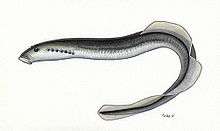 |
Hyperoartia (lamprey) |
|||||
| Jawed |  |
cartilaginous fish |
||||
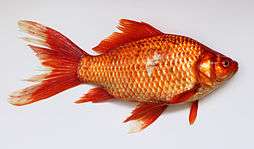 |
ray-finned fish |
|||||
 |
lobe-finned fish |
|||||
| Tetrapods | 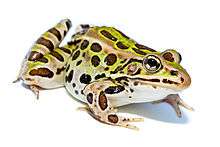 |
amphibians | 7,302 | 33,278 | ||
| Amniote have amniotic membrane adapted to reproducing on land |
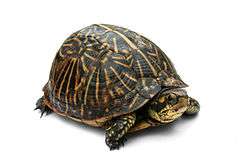 |
reptiles | 10,038 | |||
_2.jpg) |
birds | 10,425 | ||||
.png) |
mammals | 5,513 | ||||
| Total described species | 66,178 | |||||
The IUCN estimates that 1,305,075 extant invertebrate species have been described,[33] which means that less than 5% of the described animal species in the world are vertebrates.
See also
References
- 1 2 Shu; et al. (4 November 1999). "Lower Cambrian vertebrates from south China". Nature 402 (6757): 42–46. Bibcode:1999Natur.402...42S. doi:10.1038/46965.
- 1 2 Nielsen, C. (2012). "The authorship of higher chordate taxa". Zoologica Scripta 41 (4): 435–436. doi:10.1111/j.1463-6409.2012.00536.x.
- ↑ Jonathan E.M. Baillie; et al. (2004). "A Global Species Assessment". World Conservation Union.
- ↑ Kuraku; et al. (December 1999). "Monophyly of Lampreys and Hagfishes Supported by Nuclear DNA–Coded Genes". Journal of Molecular Evolution 49 (6): 729–35. doi:10.1007/PL00006595. PMID 10594174.
- ↑ Stock, David; Whitt GS (7 August 1992). "Evidence from 18S ribosomal RNA sequences that lampreys and hagfish form a natural group". Science 257 (5071): 787–9. Bibcode:1992Sci...257..787S. doi:10.1126/science.1496398. PMID 1496398. Retrieved 22 November 2011.
- ↑ Nicholls, Henry (10 September 2009). "Mouth to Mouth". Nature 461 (7261): 164–166. doi:10.1038/461164a. PMID 19741680.
- ↑ Douglas Harper, Historian. "vertebrate". Online Etymology Dictionary. Dictionary.com.
- ↑ Douglas Harper, Historian. "vertebra". Online Etymology Dictionary. Dictionary.com.
- ↑ Waggoner, Ben. "Vertebrates: More on Morphology". UCMP. Retrieved 13 July 2011.
- 1 2 3 4 5 6 Romer, A.S. (1949): The Vertebrate Body. W.B. Saunders, Philadelphia. (2nd ed. 1955; 3rd ed. 1962; 4th ed. 1970)
- ↑ Liem, Karel F.; Warren Franklin Walker (2001). Functional anatomy of the vertebrates: an evolutionary perspective. Harcourt College Publishers. p. 277. ISBN 978-0-03-022369-3.
- ↑ Scott, Thomas (1996). Concise encyclopedia biology. Walter de Gruyter. p. 542. ISBN 978-3-11-010661-9.
- ↑ "The Origin of the Larva and Metamorphosis in Amphibia". The American Naturalist (Essex Institute) 91: 287. 1957. doi:10.1086/281990. JSTOR 2458911.
- ↑ Clack, J. A. (2002): Gaining ground: the origin and evolution of tetrapods. Indiana University Press, Bloomington, Indiana. 369 pp
- ↑ Teng, L. and Labosky P. A. (2006). "Neural crest stem cells" In: Jean-Pierre Saint-Jeannet, Neural Crest Induction and Differentiation, pp. 206-212, Springer Science & Business Media. ISBN 9780387469546.
- ↑ Gans, C.; Northcutt, R. G. (1983). "Neural crest and the origin of vertebrates: a new head". Science 220 (4594): 268–273. doi:10.1126/science.220.4594.268.
- ↑ Bronner, M. E.; LeDouarin, N. M. (2012). "Evolution and development of the neural crest: An overview". Developmental Biology 366 (1): 2–9. doi:10.1016/j.ydbio.2011.12.042. PMC 3351559. PMID 22230617.
- ↑ Dupin E, Creuzet S and Le Douarin NM (2007) "The Contribution of the Neural Crest to the Vertebrate Body". In: Jean-Pierre Saint-Jeannet, Neural Crest Induction and Differentiation, pp. 96–119, Springer Science & Business Media. ISBN 9780387469546. doi:10.1007/978-0-387-46954-6_6. Full text
- 1 2 Hildebrand, M. & Gonslow, G. (2001): Analysis of Vertebrate Structure. 5th edition. John Wiley & Sons, Inc. New York
- ↑ "Keeping an eye on evolution". PhysOrg.com. 3 December 2007. Retrieved 4 December 2007.
- ↑ Hyperotreti - Hagfishes
- ↑ Waggoner, Ben. "Vertebrates: Fossil Record". UCMP. Retrieved 15 July 2011.
- ↑ Tim Haines, Paul Chambers (2005). The Complete Guide to Prehistoric Life. Firefly Books.
- ↑ Donoghue, P. C. J.; Forey, P. L.; Aldridge, R. J. (2000). "Conodont affinity and chordate phylogeny". Biological Reviews 75 (2): 191–251. doi:10.1017/S0006323199005472. PMID 10881388.
- ↑ Encyclopaedia Britannica: a new survey of universal knowledge, Volume 17. Encyclopædia Britannica. 1954. p. 107.
- ↑ Berg, Linda R.; Eldra Pearl Solomon; Diana W. Martin (2004). Biology. Cengage Learning. p. 599. ISBN 978-0-534-49276-2.
- ↑ Cloudsley-Thompson, J. L. (2005). Ecology and behaviour of Mesozoic reptiles. 9783540224211: Springer. p. 6.
- ↑ Chalopin D, Tomaszkiewicz M, Galiana D, Volff JN. (2012). LTR Retroelement-Derived Protein-Coding Genes and Vertebrate Evolution. In: Witzany G (ed). Viruses: Essential Agents of Life, Springer, Dordrecht, pp 269-282.
- ↑ Andersen, Nils Møller; Tom A. Weir (2004). Australian water bugs: their biology and identification (Hemiptera-Heteroptera, Gerromorpha & Nepomorpha). Apollo Books. p. 38. ISBN 978-87-88757-78-1.
- ↑ Hildebran, M. & Gonslow, G. (2001): Analysis of Vertebrate Structure. 5th edition. John Wiley & Sons, Inc. New York, page 33: Comment: The problem of naming sister groups
- 1 2 Benton, Michael J. (1 November 2004). Vertebrate Palaeontology (Third ed.). Blackwell Publishing. pp. 33, 455 pp. ISBN 978-0632056378.
- ↑ Janvier, Philippe. 1997. Vertebrata. Animals with backbones. Version 1 January 1997 (under construction). http://tolweb.org/Vertebrata/14829/1997.01.01 in The Tree of Life Web Project, http://tolweb.org/
- 1 2 3 4 The World Conservation Union. 2014. IUCN Red List of Threatened Species, 2014.3. Summary Statistics for Globally Threatened Species. Table 1: Numbers of threatened species by major groups of organisms (1996–2014).
Bibliography
- Kardong, Kenneth V. (1998). Vertebrates: Comparative Anatomy, Function, Evolution (second ed.). USA: McGraw-Hill. pp. 747 pp. ISBN 0-697-28654-1.
- "Vertebrata". Integrated Taxonomic Information System. Retrieved 6 August 2007.
External links
| Wikispecies has information related to: Vertebrata |
- Tree of Life
- Tunicates and not cephalochordates are the closest living relatives of vertebrates
- Vertebrate Pests chapter in United States Environmental Protection Agency and University of Florida/Institute of Food and Agricultural Sciences National Public Health Pesticide Applicator Training Manual
- The Vertebrates
- The Origin of Vertebrates Marc W. Kirschner, iBioSeminars, 2008.
| ||||||||||||||||||||||||||||||||||||||||||||||||||||||||||||||||||||||||||||||||||||||||||||||||||||||||||||||||||||||||||||||
| ||||||||||||||||||||||||||||||||||||||||||||||||||||||||||||||||||||||||||||||||
|